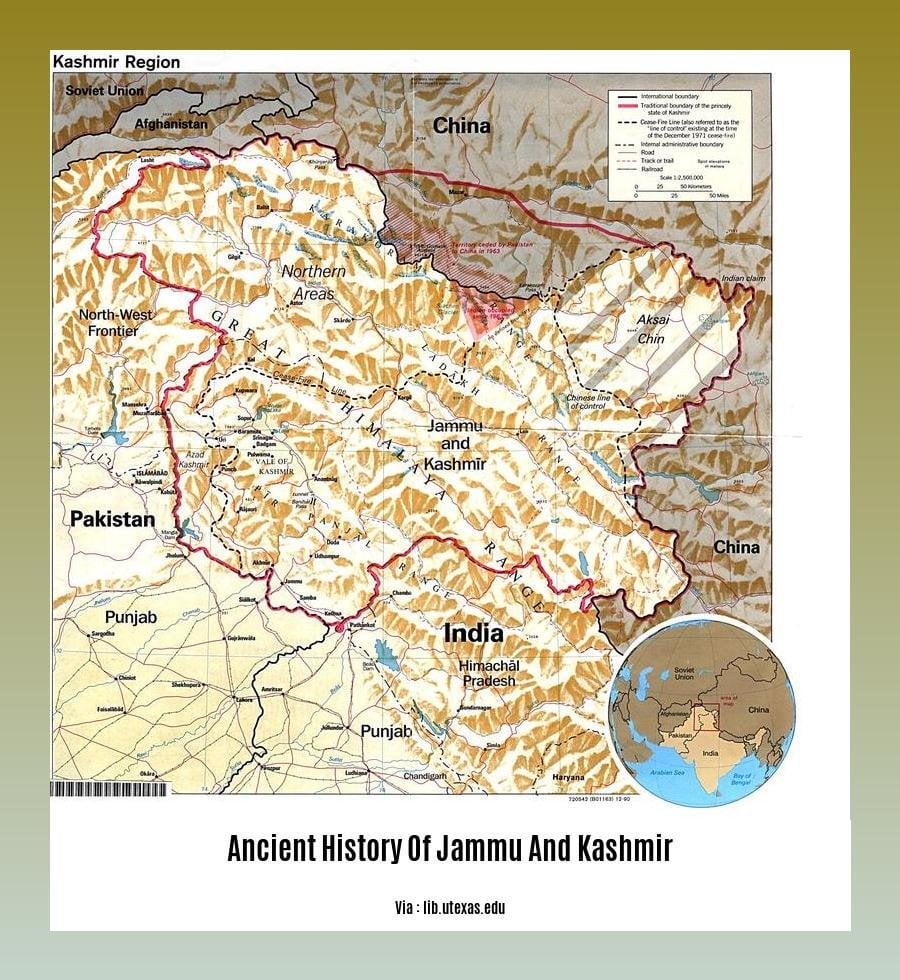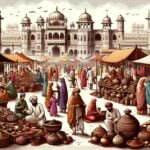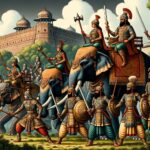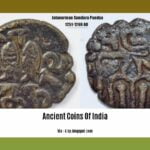Step into the annals of time as we embark on an extraordinary journey through the ancient history of Jammu and Kashmir. From the enigmatic remnants of ancient civilizations to the grandeur of forgotten empires, this land holds a treasure trove of historical wonders waiting to be discovered. Join us as we delve into the depths of antiquity to unveil the captivating stories of a region that has stood the test of time.
Key Takeaways:
- The history of Jammu and Kashmir is interwoven with the history of the broader Indian subcontinent and has been influenced by Central and East Asia.
- The original term “Kashmir” only referred to the Kashmir Valley in the Western Himalayas.
- Today, the term encompasses a larger area that includes the Indian-administered union territories of Jammu and Kashmir (including Jammu and the Kashmir Valley) and Ladakh, the Pakistan-administered territories of Azad Kashmir and Gilgit-Baltistan, and the Chinese-administered regions of Aksai Chin and the Trans-Karakoram Tract.
- The region became an important center of Hinduism in the first half of the 1st millennium and later, under the Mauryas and Kushanas, of Buddhism.
- In the ninth century, during the rule of the Karkota Dynasty, a native tradition of Shaivism emerged.
Ancient History of Jammu and Kashmir
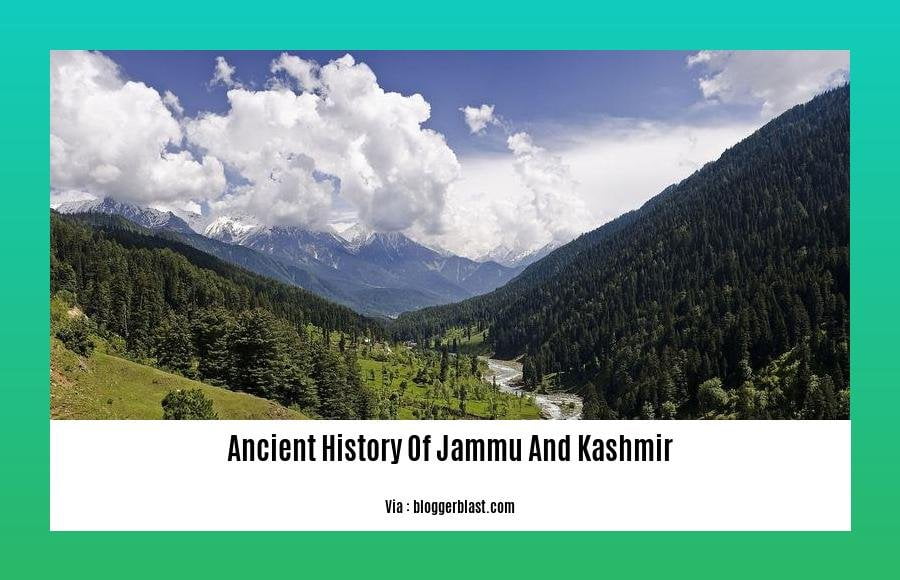
The ancient history of Jammu and Kashmir is a captivating tale of diverse cultures, empires, and civilizations. From the earliest settlements to the rise of powerful kingdoms, this region’s rich heritage is a fascinating tapestry of human history.
Earliest Civilizations
The earliest known inhabitants of Jammu and Kashmir were nomadic tribes who arrived in the region around 3000 BC. These tribes settled in the valleys and began practicing agriculture, gradually establishing permanent settlements. The region’s strategic location at the crossroads of Central and South Asia made it a hub for trade and cultural exchange.
Rise of Empires
In the 6th century BC, the region came under the rule of the Mauryan Empire, one of the largest and most powerful empires in ancient India. The Mauryans introduced Buddhism to the region, which became a major religion alongside Hinduism. The Mauryan period was followed by the rule of the Kushan dynasty, who expanded the empire’s territory further into Central Asia.
Hindu and Buddhist Kingdoms
After the decline of the Kushan Empire, Jammu and Kashmir was ruled by a series of Hindu and Buddhist kingdoms. The Karkota Dynasty, which ruled from the 7th to the 9th century AD, was a particularly significant period in the region’s history. The Karkotas were responsible for the construction of many temples and monasteries, including the famous Martand Sun Temple.
Arrival of Islam
In the 14th century, Islam arrived in Jammu and Kashmir with the conquest of the region by the Delhi Sultanate. The arrival of Islam marked a significant turning point in the region’s history, as it led to the gradual conversion of the population to Islam. However, Hinduism and Buddhism continued to be practiced by a significant minority of the population.
Mughal Rule
In the 16th century, Jammu and Kashmir came under the rule of the Mughal Empire. The Mughals were responsible for a period of peace and prosperity in the region. They built roads, bridges, and canals, and encouraged trade and commerce. The Mughal period also saw the construction of many mosques and other Islamic monuments.
Dogra Rule
In the 19th century, Jammu and Kashmir came under the rule of the Dogra dynasty. The Dogras were a Hindu dynasty that ruled the region for over a century. The Dogra period was a time of relative peace and stability, and the region experienced significant economic and cultural development.
Modern History
In 1947, Jammu and Kashmir became a part of the newly independent India. However, the region’s status has been disputed by Pakistan since then. The two countries have fought several wars over the region, and it remains a source of tension between them.
Today, Jammu and Kashmir is a multicultural and multi-ethnic region with a rich and diverse history. The region’s ancient heritage continues to shape its present-day culture, and the people of Jammu and Kashmir are proud of their unique identity.
To delve deeper into the captivating history of ancient Egypt, uncover its division into 31 distinct periods in this fascinating article: ancient egypt history is divided into 31. Embark on a musical journey through time as we explore the ancient history of music, tracing its evolution from humble beginnings to its profound impact on civilizations: ancient history of music. Discover the captivating topics that illuminate the ancient world, from its empires and cultures to its art and architecture, in this comprehensive guide: ancient world history topics.
The Mughal Empire Conquered the Region in the 16th Century and Ruled It Until the 18th Century.
The Mughal dynasty’s reign marked a chapter of profound transformation for the region. In the 16th century, the empire’s iron-fisted grip stretched over Jammu and Kashmir, asserting its dominance for over two centuries. The Mughal Empire conquered the region in the 16th century and ruled it until the 18th century, leaving an indelible imprint on the region’s history, culture, and society.
The Mughal era ushered in a period of unparalleled splendor, characterized by the patronage of arts, architecture, and literature. The Mughals were ardent builders, their architectural masterpieces, like the Shalimar Gardens and the Tomb of Jahangir, showcased their architectural prowess and continue to captivate visitors to this day.
Key Takeaways:
- The Mughal era brought peace and stability to a region that had witnessed centuries of conflict and strife.
- The Mughal Empire initiated various administrative reforms, introducing a more centralized and efficient system of governance.
- The empire’s patronage of the arts and architecture led to the creation of magnificent monuments and the development of new artistic styles.
- The Mughal Empire played a pivotal role in spreading Islam in Jammu and Kashmir, leading to the construction of numerous mosques and the conversion of a significant portion of the population.
- The empire’s policies of religious tolerance and interfaith dialogue fostered an environment of harmony and mutual respect among different communities.
Sources:
- Mughal Empire
- The Mughal Empire in India
The Sikh Empire conquered Jammu and Kashmir in the 19th century and ruled it until the British Raj took control of the region in 1846.
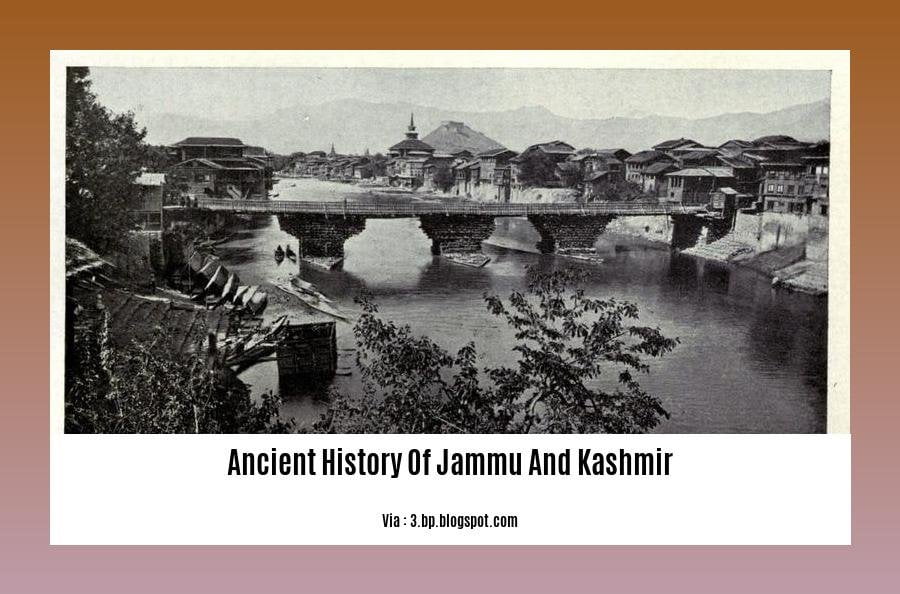
The Sikh Empire, a prominent force in the Punjab region of South Asia, extended its influence over Jammu and Kashmir during the 19th century. With its roots in Ranjit Singh’s leadership, the Sikh Empire embarked on a conquest that brought the region under its rule. The empire’s reign, though relatively brief, left a lasting impact on the cultural, political, and social fabric of Jammu and Kashmir.
Conquests and Consolidation:
- Ranjit Singh’s strategic military campaigns brought significant territories under the Sikh Empire’s control.
- Jammu and Kashmir, with its rich resources and strategic location, became a coveted region for the expanding empire.
- Through a series of military maneuvers, the Sikh forces successfully incorporated the region into their growing dominion.
Administration and Governance:
- The Sikh Empire established an administrative system that brought order and stability to the region.
- Local governance structures were implemented, allowing for a degree of autonomy while maintaining central control.
- Efforts were made to promote trade and commerce, leading to economic growth and increased prosperity.
Resistance and Revolts:
- Despite the empire’s attempts at consolidation, there were occasional pockets of resistance from local rulers and communities.
- These uprisings were met with swift military action to maintain the empire’s dominance.
- However, these challenges highlighted the complex dynamics of governance in a diverse region like Jammu and Kashmir.
British Intervention and the End of Sikh Rule:
- The Sikh Empire’s reign in Jammu and Kashmir came to an end with the British intervention in the region.
- After the Anglo-Sikh Wars, the British emerged as the dominant power in the Indian subcontinent.
- In 1846, the Treaty of Amritsar was signed, which resulted in the transfer of Jammu and Kashmir to British control.
Key Takeaways:
- The Sikh Empire’s conquest of Jammu and Kashmir in the 19th century was a significant event in the region’s history.
- The empire’s reign, though relatively brief, had a lasting impact on the region’s cultural, political, and social landscape.
- The empire’s administrative system brought order and stability, while its efforts to promote trade and commerce contributed to economic growth.
- Resistance and revolts against the empire highlighted the complexities of governance in a diverse region.
- The empire’s rule in Jammu and Kashmir ended with the British intervention and the signing of the Treaty of Amritsar in 1846.
Sources:
– Sikh Empire – Wikipedia
– Jammu and Kashmir – Britannica
Jammu and Kashmir Became a Part of the Indian Union After the Partition of India in 1947.
In 1947, the British Raj was abolished, and India was partitioned into two independent nations: India and Pakistan. Jammu and Kashmir became a part of the Indian Union after the partition of India in 1947. But, the partition also sparked a conflict between India and Pakistan over the region, which continues to this day.
This decision was based on several factors, including the region’s geographical location, the predominantly Muslim population, and the role of Maharaja Hari Singh, the ruler of Jammu and Kashmir at the time.
The decision to join India was not without its challenges. Pakistan objected to the accession, claiming that it was not in line with the wishes of the Kashmiri people. This led to the first India-Pakistan war in 1947, which ended in a ceasefire and the division of Kashmir into two parts: India-administered Kashmir and Pakistan-administered Kashmir.
The dispute over Kashmir has continued for decades, with both India and Pakistan claiming the entire region. There have been several wars and conflicts between the two countries over the issue, and it remains a major source of tension in the region.
The Indian government has implemented various policies and programs to promote development and improve the lives of the people of Jammu and Kashmir. These include investments in infrastructure, education, and healthcare, as well as initiatives to promote tourism and economic growth.
Key Takeaways:
- The partition of India in 1947 led to the creation of two independent nations: India and Pakistan.
- Jammu and Kashmir became a part of the Indian Union after the partition of India in 1947.
- The decision to join India was based on several factors, including the region’s geographical location, the predominantly Muslim population, and the role of Maharaja Hari Singh.
- India and Pakistan have been disputing over Kashmir since 1947, which has led to wars and conflicts between the two countries.
- The Indian government has implemented various policies and programs to promote development and improve the lives of the people of Jammu and Kashmir.
Sources:
FAQ
Q1: What is the significance of Kashmir in ancient history?
A1: Kashmir has held a prominent place in ancient history as a significant center of Hinduism and Buddhism during different periods. It later developed its unique tradition of Shaivism under the Karkota Dynasty in the ninth century, showcasing its rich cultural and religious heritage.
Q2: How did the Mughal Empire impact the history of Jammu and Kashmir?
A2: The Mughal Empire, ruled by the Turkic-Mongol dynasty, expanded its influence over the Indian subcontinent, including Jammu and Kashmir. During the reign of the Mughal ruler Akbar, the empire reached its zenith and controlled a substantial portion of the region, leaving a lasting impact on its history and governance.
Q3: What role did the Sikh Empire play in the history of Jammu and Kashmir?
A3: The Sikh Empire, founded by Ranjit Singh, emerged in the 18th century and established its presence in the Punjab region, which included parts of Jammu and Kashmir. The empire’s influence in the region grew, leading to the establishment of the Maharaja of the Sikh Empire in Lahore.
Q4: What is the historical significance of Jammu and Kashmir’s two capitals, Jammu and Srinagar?
A4: Jammu and Srinagar, the two capitals of Jammu and Kashmir, hold historical significance as centers of governance and cultural heritage. Jammu, the winter capital, offers a glimpse into the ancient Dogra Rajput heritage, while Srinagar, the summer capital, showcases the region’s rich cultural tapestry, including its Mughal and Kashmiri influences.
Q5: How has the ancient history of Jammu and Kashmir influenced its present-day culture and identity?
A5: The ancient history of Jammu and Kashmir has profoundly shaped its current cultural landscape. The region’s diverse heritage, influenced by various empires and dynasties, has left an indelible mark on its art, architecture, cuisine, and languages. This rich amalgamation of historical influences continues to contribute to the unique identity of Jammu and Kashmir, making it a culturally vibrant and fascinating region.
- Senior at What Age: Benefits & Eligibility Guide - March 29, 2025
- Unlocking Senior Benefits: How Old is a Senior? Your Complete Guide - March 29, 2025
- Master Russian Politeness:A Guide to Saying Please - March 29, 2025
